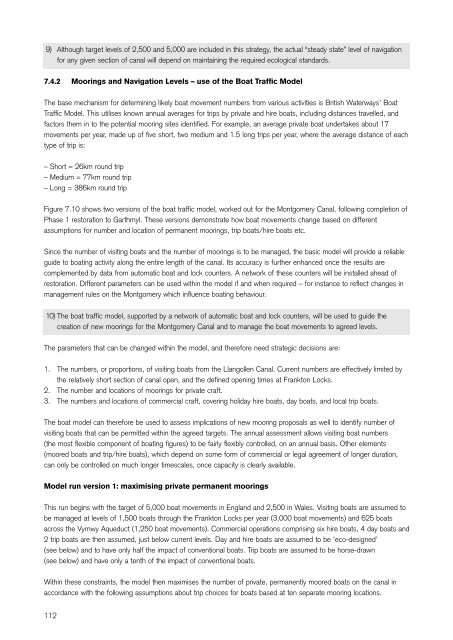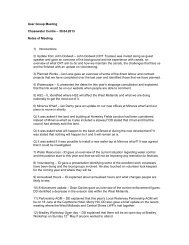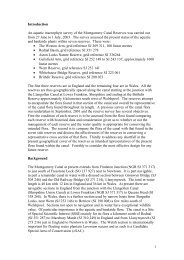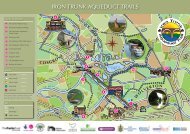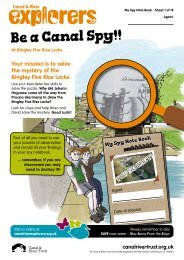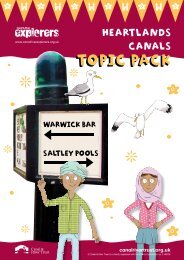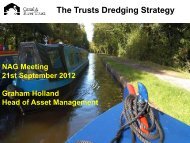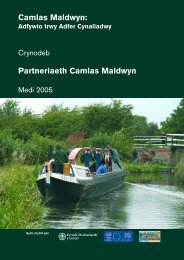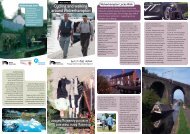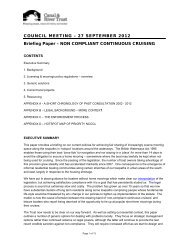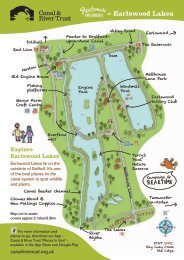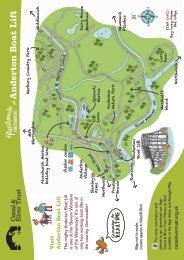Montgomery Canal Conservation Management Strategy (1.2MB PDF)
Montgomery Canal Conservation Management Strategy (1.2MB PDF)
Montgomery Canal Conservation Management Strategy (1.2MB PDF)
You also want an ePaper? Increase the reach of your titles
YUMPU automatically turns print PDFs into web optimized ePapers that Google loves.
9) Although target levels of 2,500 and 5,000 are included in this strategy, the actual “steady state” level of navigation<br />
for any given section of canal will depend on maintaining the required ecological standards.<br />
7.4.2 Moorings and Navigation Levels – use of the Boat Traffic Model<br />
The base mechanism for determining likely boat movement numbers from various activities is British Waterways’ Boat<br />
Traffic Model. This utilises known annual averages for trips by private and hire boats, including distances travelled, and<br />
factors them in to the potential mooring sites identified. For example, an average private boat undertakes about 17<br />
movements per year, made up of five short, two medium and 1.5 long trips per year, where the average distance of each<br />
type of trip is:<br />
– Short = 26km round trip<br />
– Medium = 77km round trip<br />
– Long = 386km round trip<br />
Figure 7.10 shows two versions of the boat traffic model, worked out for the <strong>Montgomery</strong> <strong>Canal</strong>, following completion of<br />
Phase 1 restoration to Garthmyl. These versions demonstrate how boat movements change based on different<br />
assumptions for number and location of permanent moorings, trip boats/hire boats etc.<br />
Since the number of visiting boats and the number of moorings is to be managed, the basic model will provide a reliable<br />
guide to boating activity along the entire length of the canal. Its accuracy is further enhanced once the results are<br />
complemented by data from automatic boat and lock counters. A network of these counters will be installed ahead of<br />
restoration. Different parameters can be used within the model if and when required – for instance to reflect changes in<br />
management rules on the <strong>Montgomery</strong> which influence boating behaviour.<br />
10) The boat traffic model, supported by a network of automatic boat and lock counters, will be used to guide the<br />
creation of new moorings for the <strong>Montgomery</strong> <strong>Canal</strong> and to manage the boat movements to agreed levels.<br />
The parameters that can be changed within the model, and therefore need strategic decisions are:<br />
1. The numbers, or proportions, of visiting boats from the Llangollen <strong>Canal</strong>. Current numbers are effectively limited by<br />
the relatively short section of canal open, and the defined opening times at Frankton Locks.<br />
2. The number and locations of moorings for private craft.<br />
3. The numbers and locations of commercial craft, covering holiday hire boats, day boats, and local trip boats.<br />
The boat model can therefore be used to assess implications of new mooring proposals as well to identify number of<br />
visiting boats that can be permitted within the agreed targets. The annual assessment allows visiting boat numbers<br />
(the most flexible component of boating figures) to be fairly flexibly controlled, on an annual basis. Other elements<br />
(moored boats and trip/hire boats), which depend on some form of commercial or legal agreement of longer duration,<br />
can only be controlled on much longer timescales, once capacity is clearly available.<br />
Model run version 1: maximising private permanent moorings<br />
This run begins with the target of 5,000 boat movements in England and 2,500 in Wales. Visiting boats are assumed to<br />
be managed at levels of 1,500 boats through the Frankton Locks per year (3,000 boat movements) and 625 boats<br />
across the Vyrnwy Aqueduct (1,250 boat movements). Commercial operations comprising six hire boats, 4 day boats and<br />
2 trip boats are then assumed, just below current levels. Day and hire boats are assumed to be ‘eco-designed’<br />
(see below) and to have only half the impact of conventional boats. Trip boats are assumed to be horse-drawn<br />
(see below) and have only a tenth of the impact of conventional boats.<br />
Within these constraints, the model then maximises the number of private, permanently moored boats on the canal in<br />
accordance with the following assumptions about trip choices for boats based at ten separate mooring locations.<br />
112


